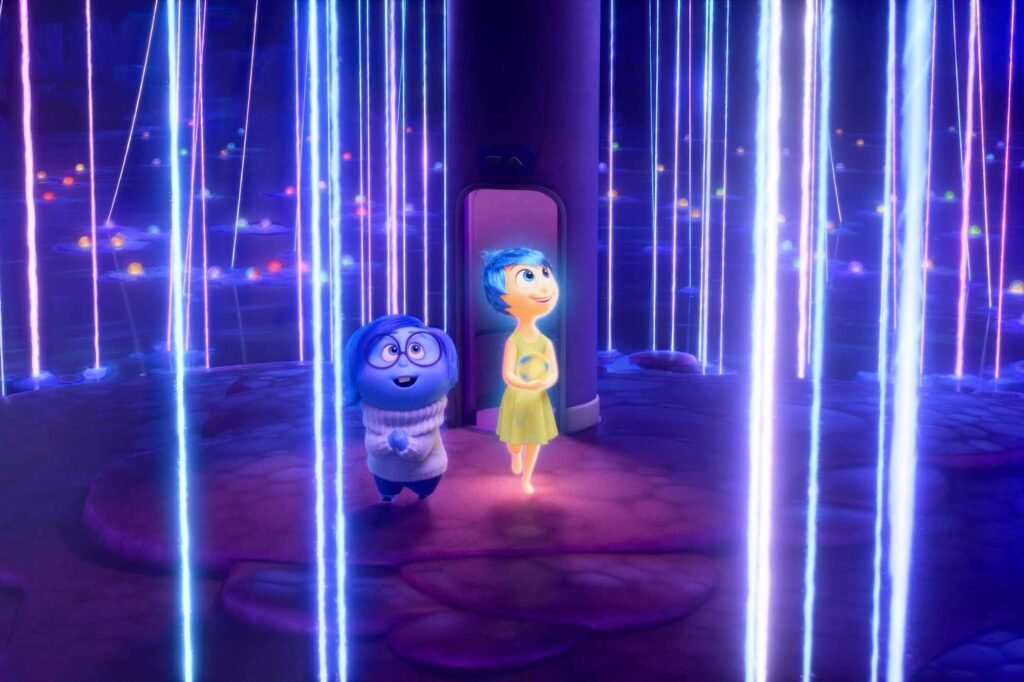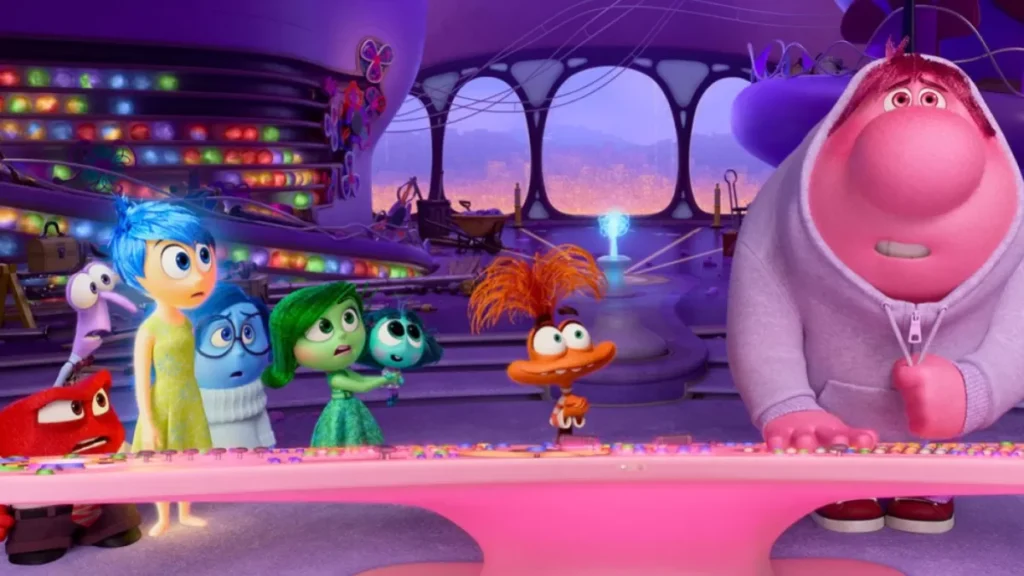Pixar’s Inside Out 2 taps into a cultural and emotional zeitgeist that resonates across generations: the rise of digital technology and its profound influence on adolescence. In this much-anticipated sequel, we revisit Riley, now a teenager navigating the tumultuous waters of high school, friendships, and self-discovery. But this time, there’s a new dynamic in play — her constant attachment to her smartphone.
The theme of “Inside Out 2 Always on Phone” speaks directly to one of the most pressing questions in parenting, psychology, and youth culture today: What happens to our inner emotional world when we’re always plugged in?
Inside Out 2: A Glimpse into Riley’s New Emotional Landscape
In the original Inside Out (2015), audiences were captivated by the whimsical representation of emotions inside young Riley’s mind. Joy, Sadness, Fear, Anger, and Disgust served as emotional avatars, shaping her memories and experiences.
In Inside Out 2, Riley’s growing up — and so is her emotional complexity. New emotions like Anxiety, Envy, and Embarrassment make their entrance. But what stands out more than these new characters is how omnipresent her phone is in her life.
Riley’s phone is no longer a device; it’s a portal into her self-image, social standing, and emotional feedback loop.
The Symbolism of the Smartphone: More Than a Gadget
The Phone as a Mirror
In Inside Out 2, Riley’s phone functions symbolically as a mirror reflecting her perceived identity. She scrolls through social media, seeing highlight reels of friends’ lives and influencers’ idealized lifestyles. Her emotions are directly affected by what she sees on screen:
- A post from a friend without her in it triggers sadness.
- A text that goes unanswered sparks anxiety.
- A selfie gets fewer likes than usual, and embarrassment floods her mind.
Pixar portrays the phone not merely as a source of entertainment but as a catalyst for emotional highs and lows.
Notifications: Emotional Triggers
One of the most clever visual metaphors in the film involves push notifications. Inside Riley’s mind, these pings light up the Headquarters like alarm bells, drawing the attention of different emotions depending on the content:
- A like on her post = Joy rushes to the controls.
- A harsh comment = Anger takes the wheel.
- A Snapchat streak ends = Panic from Anxiety.
The “Inside Out 2 Always on Phone” theme makes a powerful statement: emotional regulation is becoming intertwined with external digital validation.
The Science Behind the Screen: What the Film Gets Right
Pixar consulted child psychologists and behavioral researchers for both Inside Out films. The sequel draws heavily from recent psychological studies on smartphone use in adolescence, and it shows.
Dopamine and Digital Dependency
Riley’s joy at receiving likes, messages, and streaks is grounded in science. Social media interactions stimulate dopamine, the brain’s reward chemical. Over time, the brain associates the phone with pleasure, creating a compulsive need to check it — even in the middle of conversations, meals, or sports.
In Inside Out 2, we see Riley checking her phone reflexively, even when she’s supposed to be present in real-life moments. The emotions inside her mind start to argue over whether this digital interaction is truly satisfying or just a habit.
The Fragmentation of Focus
The film subtly highlights how constant phone use fragments Riley’s attention. While trying to focus in class or during hockey practice, her mind is bombarded by distractions from her phone. This dissonance between the outer world and her inner emotional world leads to emotional burnout.
Pixar doesn’t vilify the phone — instead, it illustrates how technology can amplify insecurities and interrupt emotional growth if not managed wisely.
Emotional Hijacking: When Digital Life Takes Over

Anxiety’s Rise in the Digital Age
One of the standout moments in Inside Out 2 is when Anxiety takes over Headquarters, reflecting the all-too-real rise of anxiety disorders in teens. Much of Riley’s anxiety is triggered or worsened by her phone:
- Waiting for a reply from a crush
- Overanalyzing a selfie before posting it
- Comparing her life to others online
This moment illustrates emotional hijacking — when digital experiences override real-world emotional resilience.
Joy’s Struggle to Be Heard
As Riley spends more time on her phone, Joy — once the leader — finds it harder to assert control. She’s drowned out by louder, more reactive emotions like Envy and Embarrassment. This narrative arc is Pixar’s way of saying that joy becomes more difficult to access when we’re constantly measuring ourselves against digital standards.
A New Role for Memory: The Digital vs. the Real
Core Memories and the Scroll
In the first film, “core memories” were powerful, life-shaping experiences. In Inside Out 2, there’s an exploration of how digital moments may start to replace real-world experiences as emotional touchstones.
Riley begins to create digital core memories — a viral post, a flattering comment, or a funny meme shared with friends. But these memories are fragile and fleeting, unlike the rich, multisensory memories of her childhood.
This raises a critical question: What happens when our most cherished experiences exist only on a screen?
Memory Decay and Overstimulation
The film also illustrates how overexposure to content leads to memory decay. Riley’s emotions can’t keep up with the rapid influx of stimuli. Joy laments how difficult it is to hold onto happiness when it’s constantly being replaced by the next thing on the feed.
This captures a key concept in psychology: emotional saturation, where the brain becomes so overstimulated it dulls both joy and sorrow.
Parenting in the Age of Screens: Lessons from Inside Out 2

Creating Phone Boundaries
Riley’s parents in Inside Out 2 are portrayed as well-meaning but overwhelmed, unsure of how to navigate their daughter’s digital life. This mirrors real-world parenting dilemmas.
The film subtly encourages families to:
- Establish screen-free zones (like dinner or bedtime)
- Encourage offline hobbies that build identity outside of social media
- Talk openly about digital anxiety and emotional triggers
These aren’t heavy-handed moral lessons — they’re organically woven into the storyline, showing how balance is the key.
Empathy and Emotional Literacy
One of the most hopeful aspects of the film is when Riley begins to understand how her phone affects her emotions. She starts asking herself:
- “Why do I feel this way after scrolling?”
- “Is this real joy, or is it just validation?”
This is Pixar at its finest — using animation to model emotional intelligence and self-reflection for viewers of all ages.
The Cultural Impact of Inside Out 2: A New Conversation Starter
Beyond Entertainment: A Mirror to Our Times
Inside Out 2 isn’t just a film — it’s a cultural conversation starter. By weaving the “Always on Phone” theme into Riley’s emotional world, it invites audiences to reflect on their own digital habits.
It’s particularly impactful for:
- Teens, who see their struggles mirrored in Riley.
- Parents, who gain insight into the emotional ripple effects of screen time.
- Educators and psychologists, who can use the film as a teaching tool.
A Brave, Timely Narrative
In a media landscape often reluctant to critique technology, Inside Out 2 stands out for its nuanced, empathetic, and truthful portrayal of digital life. It doesn’t preach or blame — it simply observes and reflects, leaving the viewer wiser for having watched.
Conclusion
Inside Out 2: Always on Phone is not just a movie subtitle — it’s a reality for an entire generation. Riley’s emotional journey, shaped and sometimes distorted by her smartphone use, serves as a powerful metaphor for the challenges today’s teens face.
The film doesn’t demonize technology. Instead, it emphasizes the importance of emotional balance, self-awareness, and intentional living in a digital world. It shows us that while our phones may be here to stay, so too is our capacity for genuine joy, meaningful relationships, and real-world connection.
Just as Joy reclaims her place inside Riley’s mind, we too can learn to reclaim our emotional core — not through likes and comments, but through moments of presence, empathy, and reflection.
Read more: Reach the Highest Achievement at Sabung Ayam Juara100.org Medal: Where Champions Gather


